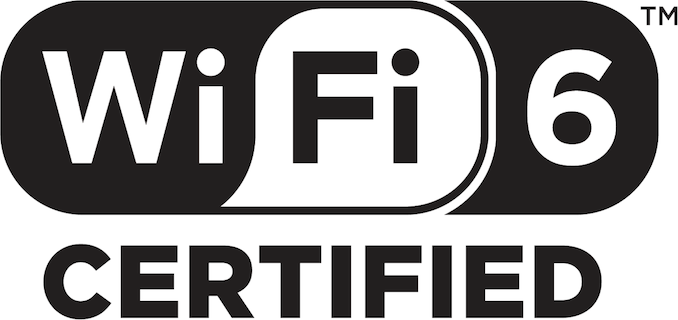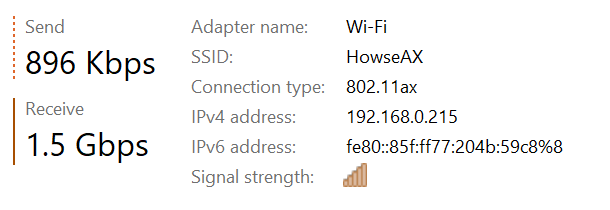AT 101: Wi-Fi 6 And Why You Want It
by Brett Howse on February 12, 2020 8:00 AM ESTTo The Future
If the question is do you need Wi-Fi 6, the answer is most assuredly “maybe”. The performance improvements are substantial, but really rely on a very strong signal to get the most data throughput. Most of the new features of Wi-Fi 6 focus on the influx of devices to the standard, and dealing with many devices connected to the same access point, or devices trying to share spectrum when connected to different access points.
The addition of Orthogonal Frequency Division Multiple Access to the Wi-Fi 6 standard will likely be the most impactful change to this revision. It will allow access points to carve up their channels into smaller slices, allowing more devices to communicate at the same time with less overhead. Each device will lose out on peak throughput, but the reduced latency should help a lot, especially in very dense environments. It should help with excessive overhead on the network layer when multiple devices are sending many small packets at once, which is a very common scenario, especially in an office or stadium situation.
Multi-User MIMO was in the Wi-Fi 5 specification as an optional implementation, and as such it did not really take off. Wi-Fi 6 should make this more prevalent, and also adds support to the MU-MIMO on the uplink, not just the downlink side. This will increase the capacity of access points for higher-speed use cases, but MU-MIMO did not get a lot of traction in Wi-Fi 5 so we will have to see how much adoption it gets in Wi-Fi 6.
The wider 160 MHz channels will offer significantly more throughput in the home environment, as we saw in our performance tests. As with the 1024-level QAM though, to see the biggest benefit you will need a strong signal. The vast majority of home networking is still limited to 1 Gigabit Ethernet, which puts Wi-Fi 6 into somewhat of an awkward spot, since it can transfer faster than most wired home networks, but even so, that is still a significant improvement over Wi-Fi 5 which would cap out around 600 Mbps on the best Wi-Fi adapters. If you work with a lot of large files, and you prefer to use Wi-Fi instead of the more consistent, yet cumbersome Ethernet, there’s still a nice boost to be had.
The future looks strong for Wi-Fi, and the Wi-Fi Alliance has made some excellent revisions to their standard to help improve Wi-Fi for the next generation of devices. As with any standards change, the impacts will not be seen right away. Both the access point, and the client need to be leveraging the new standard for the improvements to be noticeable. We’ve already seen the latest generation of smartphones start to offer Wi-Fi 6, and there’s been some movement in the PC space as well with Intel’s Project Athena. Anyone looking at a new router today should certainly opt for a Wi-Fi 6 model, but there’s likely not a major need for most people to move from Wi-Fi 5 access points right away. If you live in a heavily congested wireless area, the advantages of features like BSS coloring and Spatial Frequency Reuse should help out in those scenarios, but for people looking at purely performance, Wi-Fi 6 somewhat runs into a wall of its own making, since it can now transfer at over Gigabit speeds on a typical 2x2:2 connection. But who are we to question performance?












149 Comments
View All Comments
Holliday75 - Wednesday, February 12, 2020 - link
This is my main contention with ever using WiFi on a desktop. I game. Latency and connection stability is everything.Stochastic - Wednesday, February 12, 2020 - link
Yeah, that would be nice. These days I care about latency/jitter a lot more than raw bandwidth.willis936 - Wednesday, February 12, 2020 - link
Name checks out.On this topic: the link is only as stable as the channel. Twisted pair running at 250 MHz won't even feel your microwave turning on. On 2.4 GHz it will turn your SNR to shit. And at 5 GHz someone walking near your WAP will cause issues. Consumer ethernet might be slower (for all that it matters at 1 Gbps) but it's reliable.
PaulHoule - Wednesday, February 12, 2020 - link
Ugh, on the first page you use the word "leverage" when you really want to say "use".I remember in the 1980s when there was a brash young real estate developer from New York who used the word "leverage" a lot, most because he used debt (leverage) to expand his real estate empire. People started using "leverage" as a synonym for "use".
By the 1990s, that brash real estate developer had many of his projects fail and go bankrupt because he used too much "leverage". The misuse of the word "leverage" fell out of favor in most places, except for people who wrote technical-marketing material for the Microsoft ecosystem.
That brash real estate developer grew old and became a reality TV star, than a politician. You still see people misuse the word "leverage", but he is busy misusing other words today.
Holliday75 - Wednesday, February 12, 2020 - link
I just leveraged the "REPLY" button to leave this response.willis936 - Wednesday, February 12, 2020 - link
Somebody fire this guy.digitalgriffin - Wednesday, February 12, 2020 - link
No consumer routers offer true OFDMA. This means if you have multiple devices, your throughput drops through the floor. This is something you really didn't test for.In other words, wait. It's just like MIMO. It's broken.
https://www.smallnetbuilder.com/wireless/wireless-...
heffeque - Wednesday, February 12, 2020 - link
Sad but true. I'd say OFDMA is the most important feature in Wifi-6, and it's still not working on ANY router. Hopefully in a year or two we'll start seeing one or two routers that have received an appropriate firmware update.nathanddrews - Wednesday, February 12, 2020 - link
Interesting, I had no idea. I was waiting for a Ubiquiti Wifi6 device to hit the market before shopping for anything anyway. Hopefully this is part of the delay... (probably not).FunBunny2 - Wednesday, February 12, 2020 - link
" I was waiting for a Ubiquiti Wifi6 device to hit the market before shopping for anything anyway. "hmmm... what, if any, ISPs allow the 'client' to hook up any old router to their signal?